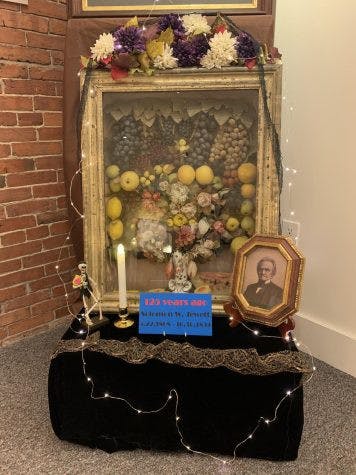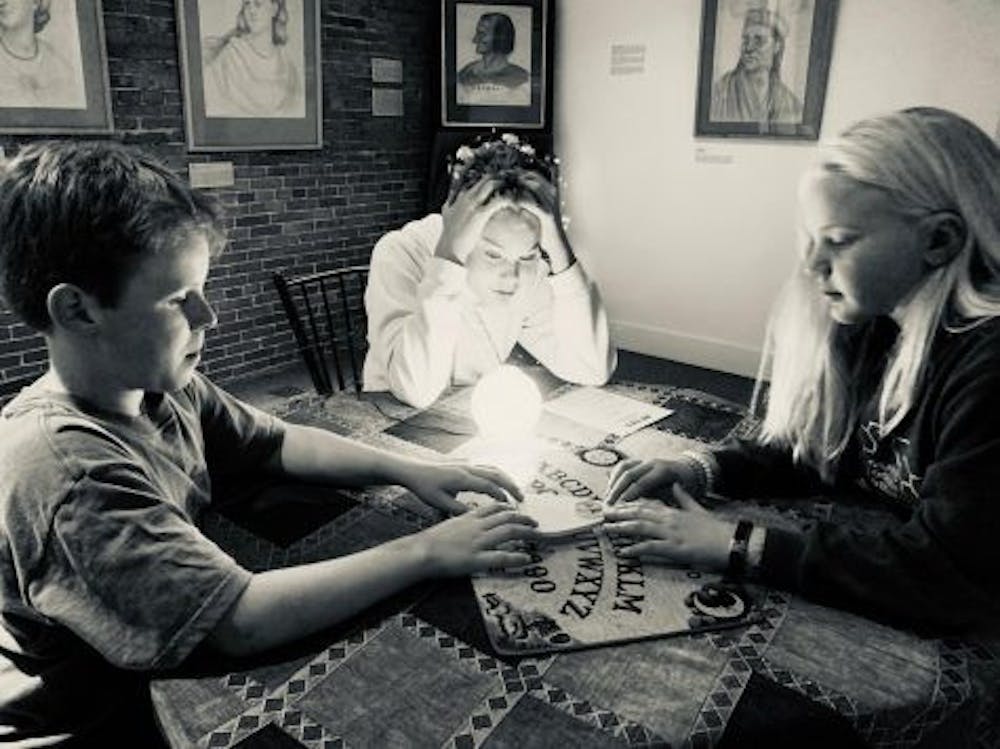The Henry Sheldon Museum celebrated its exhibit, “Conjuring the Dead,” with an array of spooky festivities on the night of Wednesday, Oct. 30. Among the hair-raising activities were fortune telling, tarot card readings, dream interpretations, ghost stories and a live music performance by Middlebury College students.
“I thought it was perfect to do this right before Halloween,” said resident Gretchen Ayer, who attended the event with her children and their friends. One of her favorite activities involved the dollhouse on the ground floor, where she and her guests collaborated in creating their own murder mystery.
Attendees also enjoyed having their dreams interpreted by dream analysts, an activity that can serve as a form of therapy and a way to unlock hidden emotions. The most popular event of the night, however, involved ghost stories. Around a glowing orb in the upstairs bedroom, attendees shared their spookiest tales.
One such ghost story involved the former location of a used bookshop in town, which used to be housed in an old storage center by the railroad tracks. Workers would hear whistling in the basement while they were supposedly alone, or would find books thrown onto the ground upon opening the store. It was later discovered that the storage facilities had not only had several deadly fires, but that they also once held dead bodies before the bodies were transported to morticians.
Ethan Mitchell, another attendee, shared his ghost story about a night he spent in a burial mound in Europe. “I really think that the idea of gathering together to share stories fills a need in this community,” he said. “This is something that Middlebury has been missing.”

Museum board members Silvia Gonzalez, Lucinda Cockrell and intern Taylor Rossini ’20 dress up for ‘Conjuring the Dead,’ an exhibit featured last Wednesday at the Sheldon Museum on Mill Street.
Wednesday night’s event was a celebration for “Conjuring the Dead: Spirit Art in the Age of Radical Reform,” an exhibit curated by Eva Garcelon-Hart, the Sheldon Museum archivist. The exhibit originated with the spirit photography of Solomon Wright Jewett (1808–1894), a resident of Weybridge who became enamored with the spiritualist movement. Jewett’s spirit photographs include images where he appears to be visited by spectral figures of historical importance, such as George Washington and Prince Albert. The exhibit also includes a letter in which Jewett accurately predicts that Sheldon would die in 1907.
“I still get shivers when I read it,” Garcelon-Hart said. Jewett died exactly 125 years before the night of the event, a strange coincidence; Garcelon-Hart did not know the date of death before planning the event.
Spiritualism was a part of several radical reform movements that took hold in Vermont and the United States in the late 1800s. Women such as 19th century spiritualist Achsa Sprague gained prominence in this era, with many becoming advocates for social reform and participating in events such as the 1858 Rutland “Free Convention.” The exhibition included letters and pamphlets distributed by these women.
“The exhibit is kind of unusual because of the unusual aspects of historical documents,” Garcelon-Hart said. “It shows what people were interested in during certain points in history.” The exhibit also features one of Garcelon-Hart’s favorite pieces, a religious chart created by William Miller. Miller founded the Millerism religion based on the second coming of Christ in the mid-19th century. By studying the Book of Daniel and creating this chart, he predicted that current life and the current world would cease to exist on October 1844.
Upstairs, the exhibit includes 18 original drawings created by friends of Jewett, Wella P. Anderson and his wife, Lizzie “Pet” Anderson. Wella was a spiritual artist who drew the figures that would visit Lizzie, who was a medium who could channel spirits. The drawings were then photographed and circulated as small cards (carte-de-visites). However, the photographs in the Sheldon were never photographed or circulated.
“Other museums only have carte-de-visites,” Garcelon-Hart said. “The only other original drawings are in Scotland.”
“The collection is just a snapshot of the amazing objects that relate to this county in Vermont,” said Associate Director Mary Manley. “They tell a wonderful story.” Manley has been involved with the Sheldon for the past 21 years.
“The Sheldon has outstanding town archives,” said Danielle Rougeau, Middlebury College archivist and president of the Sheldon Museum Board of Trustees. “They are remarkable, and every bit the caliber of anything they have at Middlebury.”

‘Conjuring the Dead’ included a shrine to 19th century Weybridge resident Solomon Wright Jewett, who was a well-known spirit photographer at the time.
When asked how Middlebury college students can get involved, Silvia Gonzalez, a member of the board of trustees, had a few ideas. “Visit, for one,” she said. “Become familiar with the collections, and volunteer.” Museum intern Taylor Rossini ’20 added that students can access the Sheldon town archives for no charge.
Board member Lucinda Cockrell emphasized the sense of community on which The Sheldon focuses. “We’d love for people to come and visit,” Cockrell said. “This is their community museum as much as it is ours.”

Lucy Townend '22 is a Managing Editor alongside Abigail Chang.
She previously served as a senior section editor, a local editor, and a copy editor.
Townend is majoring in International Politics and Economics, studying French throughout her years at Middlebury and is planning on completing a thesis focused on income inequality and regime change.
This previous summer, Townend interned as a private banking analyst at a mid-sized bank in Chicago and plans to continue her work there after graduation.




